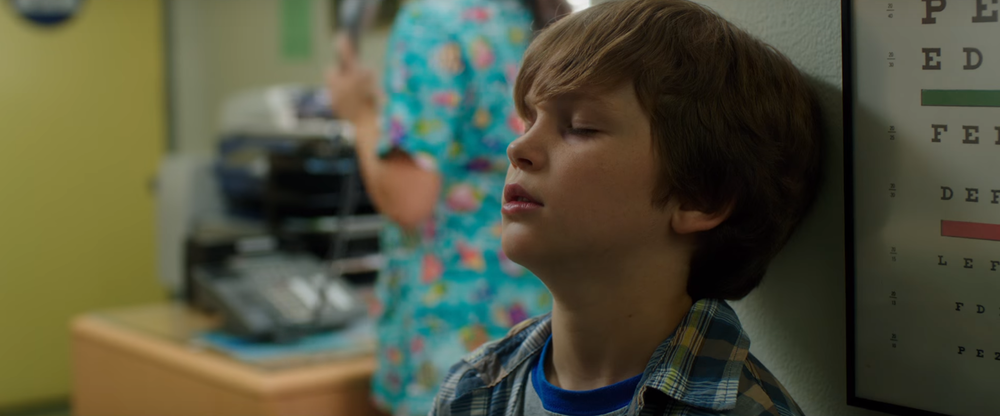Lights Out Leaves Us in the Dark
David Sandberg's debut feature relies too much on jump scares, but attempts to tackle heavy topics

David Sandberg pops his cherry in the world of big budget films with Lights Out, a horror flick based on his YouTube short of the same name. James Wan, director of The Conjuring series, takes the ambitious Swedish-born director under his wing as producer. But just how much Wan coached his new disciple remains unclear: the film rapidly becomes reliant on cheap, hackneyed jump scares, and is diagnosed by the horror-doctor as severely deficient in The Conjuring’s atmospheric buildup of spookiness. But dig a little deeper and Sandberg’s attempt at drawing a euphemism for depression using ‘Diana’ – the malevolent figure at the centre of the film – becomes apparent.
Maria Bello portrays twice-widowed Sophie – a grief-stricken mother going through a depressive episode – with an unforced feebleness that unmistakably reveals her character’s mental illness; she bears the role plausibly, informing viewers about Sophie’s condition which is tearing apart her family. Her efforts in taking care of her youngest child, Martin (Gabriel Bateman), fall short when her grown-up daughter, Rebecca (Teresa Palmer), takes Martin away to her shabby abode: a one-bedroom flat above a tattoo parlour, walls plastered with posters of Avenged Sevenfold, and creepy pictures reminiscent of dark DeviantArt illustrations. Cue battle-with-the-light-switch scenes in their flat as Diana startles the daylights out of the siblings, forcing them to reconcile with their mother.
Our villain’s origin is uncovered when Rebecca chances upon a file containing records of the hospitalisation of her mother and Diana as young children at a mental institution. Unarguably it is one of the worst backstories to be crafted in the horror genre. It is lazy and uninspired, it provides little to no scientific credibility to Diana’s supernatural ability to become invisible when exposed to light. Not that a film has to oblige the standards of the scientific community, but a backstory which is only weakly plausible seems to dilute the horror juice that keeps viewers up at night. Even after the re-telling of their sojourn at the hospital some questions remain unanswered: is Diana a ghost or a superhuman? The ending seems to suggest the former, but things are never satisfactorily clear.
Dig a little deeper and Sandberg’sattempt at drawing a euphemism for depression using ‘Diana’ becomes apparent.
Lights Out tries to present itself as a psychological horror film, a title it barely deserves. There is real harm in the actions of Diana which rules it out from being a pure ‘all in the mind’ thriller, unlike the delusional, self-harming Nina at the centre of Darren Aronovsky’s Black Swan. Sandberg’s effort at intertwining mental illness and the haunting of a scary personage propounds the idea that ‘Diana’ is to Sophie as ‘the black dog’ was to Churchill – a fascinating idea that loses a bit of its ingenuity in the final product of first-time director Sandberg. Sophie’s family is torn apart by Diana, who vows to eliminate those closest to Sophie. The clawed silhouette antagonist’s triumphs include making sure Sophie renounces her medication (or ‘vitamins’ as Martin calls them), and driving away her only pillars of support– her children. It is at this point that things begin to sound a lot like the oft swept-under-the-carpet effects of acute, untreated mental illness: breakdown of support networks and isolation of ill individuals. “There is no you without me”, remarks Sophie to her depressive parallel Diana, is a perilous statement if misconstrued and taken to heart; which raises the question to Sandberg on his directorial decision at the end of the film: what message is he sending, if he is trying to send one at all? Perhaps, after all, it is best not to dig too deep.

The film is spattered with misjudgments and mistakes on both sides: from Sophie ditching her meds, to the sibling pair leaving their mother to fend off her ‘demon’ alone, only offering help when it is too late, Lights Out brings to the fore a moral dilemma where compromises have to be made either way. Whilst it is easier (and nobler) to claim the moral high ground, convincing oneself that the course of things would have been better handled in one’s own hands is easier said than done – actions often speak louder than words.
Lights Out tries to present itself as a psychological horror film, a title it barely deserves.
Lights Out is highly entertaining and slightly terrifying with its B-grade villain that seems to have gotten more help from the make-up team than the CGI department. The serious and broody atmosphere of the film is interspersed with creative use of light sources in scaring away Diana, sometimes beckoning laughter and applause from the audience. Maria Bello, Teresa Palmer, and Gabriel Bateman create a believably dysfunctional family in which each player has their own faults, making it difficult to empathise with any of them (perhaps excluding the pre-pubescent Martin). Lights Out is one-part poignant family drama, one-part cheesy horror movie, where the premise is plain and simple: turn the lights off, scary shit ensues.








